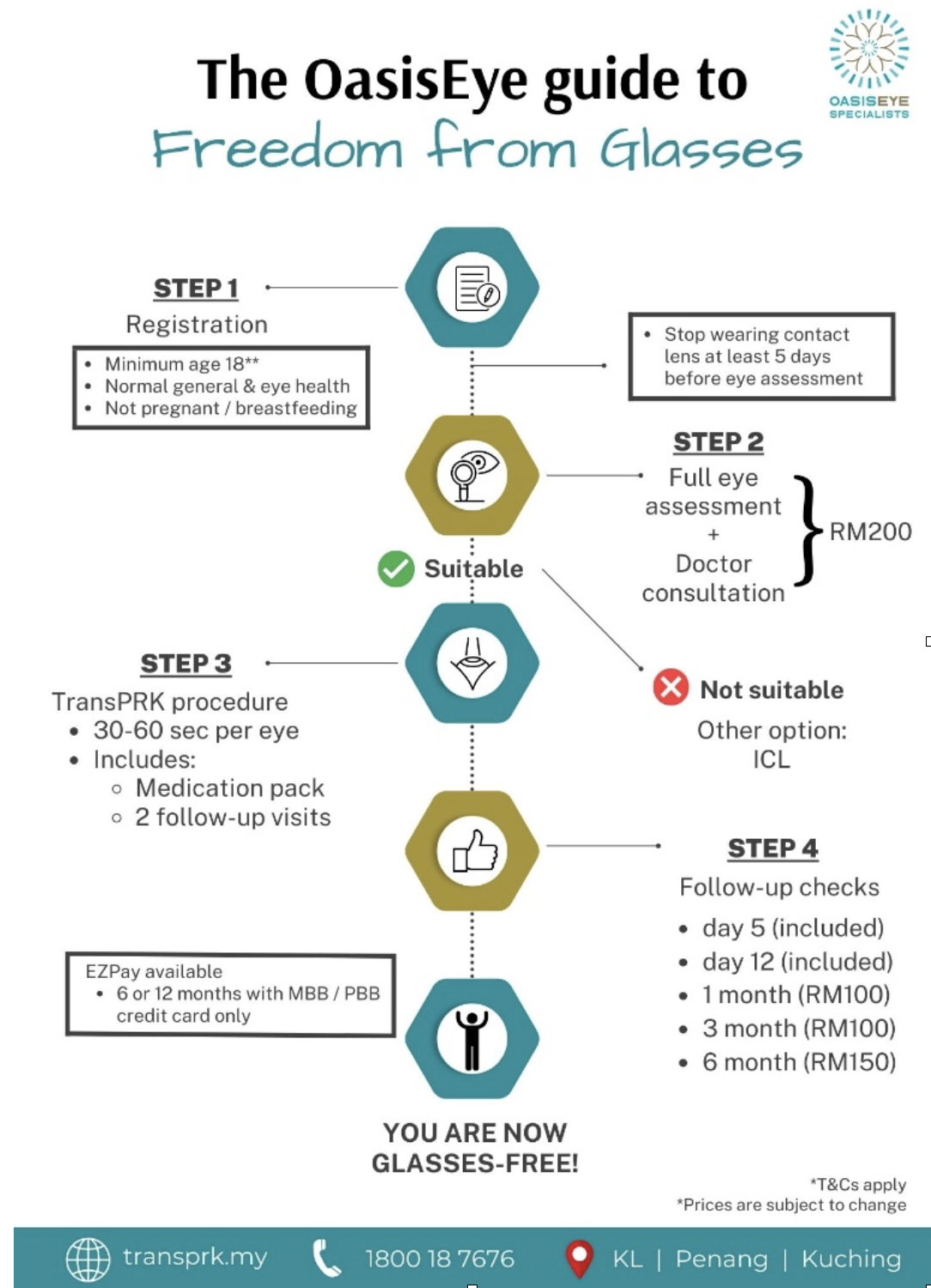Knowledge Section
Frequently Asked Questions
In terms of technique, what are the differences between TransPRK, LASIK and ReLEx SMILE?
TransPRK
- Uses a single laser to reshape the cornea surface by accurately removing the cornea epithelium and a small amount of the inner cornea layer (stroma).
- Just like our skin, the cornea epithelium has self-healing properties, so it can regenerate on its own within 3-5 days.
- To speed up the epithelium healing and reduce discomfort, a thin bandage contact lens is placed on the eye immediately after the procedure.
- This contact lens will be removed 5 days after the treatment.
LASIK
- Involves the creation of a flap on the cornea, which is created with a sharp blade (microkeratome) or Femtosecond laser machine.
- The flap is then lifted, and the stroma is ablated with an excimer laser machine.
- After that, the flap is closed back. The flap is self-sealing and does not require any sutures.
ReLEx SMILE
- A femtosecond laser is used to create a lenticule within the stroma and an incision on the cornea.
- An instrument is placed through the incision made and used to separate the upper and lower part of the lenticule within the cornea.
- This lenticule is then removed through the incision.
Am I a suitable candidate for TransPRK?
You have to undergo a full eye examination with our optometrist and doctor to determine if you are a suitable candidate. After the eye examination, you should fulfil the below requirements:
- At least 18 years old – The ‘power’ or refractive error of those below the age of 18 may not be stable yet.
- Normal cornea thickness
- No pre-existing eye conditions
- General health normal
Why are there so many tests involved?
The many tests are important to:
- Ensure that you are a suitable candidate for TransPRK
- Ensure your eyes do not have pre-existing conditions such as cataract or glaucoma
- Accurately measure your glasses prescription or ‘power’
- Measure the shape, thickness and mapping of your cornea
- Provide adequate information to advise you on the recommended refractive treatment for your eyes
We are committed to only perform surgical procedures to patients with minimal risk and understand all the possible risks involved. A comprehensive eye examination is the best way to assess the risk level of each individual eye.
What do I have to know before booking in an appointment?

How long does TransPRK surgery take?
TransPRK is the fastest refractive surgery available, taking less than 3 minutes per eye. It takes more time to prepare the operation table and clean your eyes than the laser procedure itself.
What happens in the operation room?
- After you are comfortably lying down on the operation table, your eyes will be cleaned and numbed with anaesthetic eye drops.
- A device called speculum will be used to keep your eye open during the procedure
- Your doctor will ask you to stare straight ahead at a green light
- The laser will be applied to your eye, and no sharp instruments will touch your eye
- The same will be done for your other eye
- An eye shield will be placed on both your eyes as protection, and you’re good to go home!
Can I be put to sleep or sedated for TransPRK?
Unfortunately no. You have to be fully awake to look at the green fixation light during TransPRK. Your eyes will be numb so you will not feel any pain during the procedure.
Can I be given medical certificate after TransPRK?
Yes, you can be given up to 7 days of medical leave to recover at home. You may go back to work earlier if your vision has recovered well enough and you will not be exposed to environment that can disrupt your recovery. It is advisable recover at home for the first 3 days to reduce the risk of infection. You will be given prescription antibiotic eyedrops to prevent infection and speed up your recovery.
What do I need to consider regarding TransPRK aftercare?
- It is recommended to recover at home and observe good hygiene, especially for the first week after your TransPRK treatment
- Ensure your hands are clean before handling eye drops
- Come back for your follow up visits to monitor your recovery
- During the 1st week of recovery, avoid rubbing your eyes to prevent disrupting the epithelial recovery
- Avoid going to crowded and dusty places
- Wear a pair of sunglasses when you are outdoors and exposed to sun for prolonged time. The wraparound kind would be ideal.
